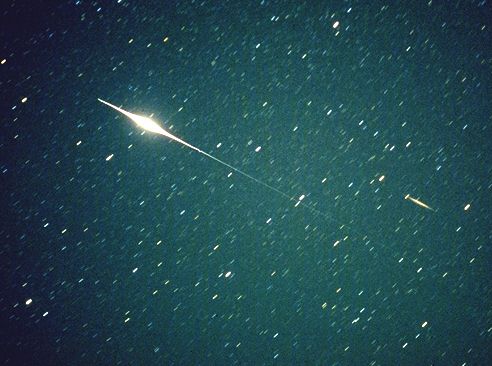
|
Credit & Copyright: Chris Dorreman
Explanation:
Have you seen
an Iridium flare?
Satellites in
low Earth orbit
reflect sunlight and
are often visible
gliding across early evening and predawn skies.
But sun glints from
Iridium commercial digital communications satellites
are providing the most spectacular sightings.
This Iridium flare photographed on September 20, 1997 by Belgian
amateur astronomer
Chris Dorreman
reached an impressive -8 magnitude (about as bright
as the half illuminated Moon).
The one minute long exposure shows
star trails nearly perpendicular to
the bright, flaring track of the satellite
and a "ghost" image of the flare at the far right.
Iridium is the 77th element and so was a good
name for the originally intended constellation of 77 satellites.
Subsequently, plans were scaled down to 66 satellites
with about 51 now in orbit and glinting away.
Typical flares last 10 to 20 seconds.
When can you catch a flare?
The brightness, timing, and direction of a flare
depend critically on your longitude and latitude, but
satellite observers can make
accurate predictions days in advance.
|
January February March April May June July August September October November December |
| ||||||||||||||||||||||||||||||||||||||||||||||||
NASA Web Site Statements, Warnings, and Disclaimers
NASA Official: Jay Norris. Specific rights apply.
A service of: LHEA at NASA / GSFC
& Michigan Tech. U.
Based on Astronomy Picture
Of the Day
Publications with keywords: Iridium sattellite - Earth orbit
Publications with words: Iridium sattellite - Earth orbit
See also:
